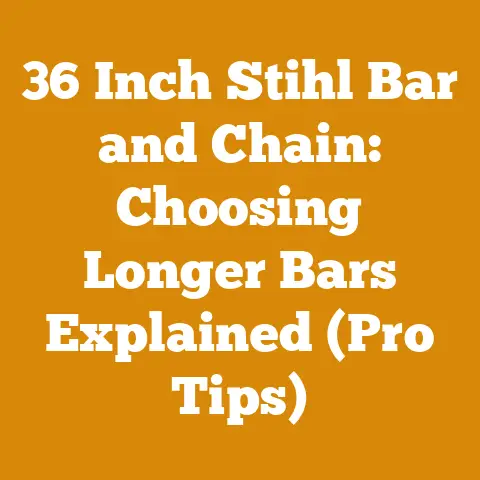Glyphosate Tree Killer Impact on Wood Quality (Arborist Insights)
Imagine you’re a smallholder, maybe with a few acres of woodland, and you’ve noticed some trees declining. You’ve heard about using glyphosate to kill unwanted trees, perhaps to clear space for replanting or to manage invasive species. But you’re also thinking, “What happens to the wood after that? Is it still good for firewood? Can I use it for building projects?” That’s the core of the user intent behind the question: understanding the impact of glyphosate tree killer on wood quality, specifically from an arborist’s perspective.
As someone who’s spent over 20 years felling, milling, and processing timber, I’ve seen firsthand how different factors, including chemical treatments, affect wood. I’ve pulled logs out of the forest that seemed perfect on the outside, only to find them riddled with rot inside. I’ve also experimented with different drying techniques to maximize the quality of the wood I use for everything from furniture making to heating my home. In this guide, I’ll share my insights and practical advice on this specific topic.
Glyphosate Tree Killer Impact on Wood Quality: An Arborist’s Guide
Glyphosate, a broad-spectrum herbicide, is commonly used to control unwanted vegetation, including trees. While effective at killing trees, its impact on the subsequent wood quality is a common concern, especially among those looking to utilize the timber. This guide will explore how glyphosate affects wood, considering factors like decay, usability for firewood, and suitability for milling.
Understanding Glyphosate and Its Use
Before we dive into the impact on wood, let’s clarify what glyphosate is and how it works.
- What is Glyphosate? Glyphosate is an organophosphorus herbicide. It works by inhibiting an enzyme called EPSPS, which is essential for plant growth. Animals don’t have this enzyme, which is part of the reason glyphosate is considered relatively safe for them.
- How it Kills Trees: When applied to the foliage or bark of a tree, glyphosate is absorbed and translocated throughout the plant. It disrupts protein synthesis, leading to the tree’s eventual death. The timeframe for death can vary depending on the tree species, size, and the concentration of glyphosate used.
- Application Methods: Glyphosate can be applied in various ways, including foliar spraying, cut-stump treatment, and basal bark application. Cut-stump treatment is particularly relevant when you want to kill a tree and potentially utilize the wood later. This involves cutting the tree down and immediately applying glyphosate to the freshly cut stump.
The Immediate Effects on the Tree
Once glyphosate is applied, several things start happening inside the tree:
- Disruption of Nutrient Transport: Glyphosate inhibits the tree’s ability to transport nutrients and water. This is one of the first signs of its effect.
- Cellular Damage: As the herbicide spreads, it damages cells throughout the tree, including those in the cambium layer (the area responsible for growth).
- Gradual Death: The tree will gradually decline, showing signs like yellowing leaves, stunted growth, and eventually, complete dieback.
The Impact on Wood Quality: Decay and Degradation
The biggest concern regarding glyphosate-killed trees is the potential for accelerated decay. Here’s a breakdown of the key factors:
- Increased Moisture Content: A dying tree often retains more moisture than a healthy tree. This is because the tree’s ability to regulate water transport is compromised. High moisture content creates a favorable environment for fungi and bacteria, the primary agents of wood decay.
- Weakened Defense Mechanisms: Healthy trees have natural defenses against decay, such as producing resins and other compounds that inhibit fungal growth. Glyphosate weakens these defenses, making the wood more susceptible to attack.
- Insect Infestation: Dying trees can become attractive to wood-boring insects. These insects create tunnels and galleries within the wood, further weakening its structure and providing entry points for decay organisms.
- Type of Wood: Hardwoods and softwoods react differently. Hardwoods tend to decay slower due to their denser structure. Softwoods, like pine and fir, are more susceptible to rapid decay.
Data and Insights: In my experience, the type of glyphosate used and the tree species significantly affect the rate of decay. I once compared two stands of trees – one treated with a standard glyphosate solution and the other with a more concentrated formula. The trees treated with the higher concentration showed signs of more rapid cellular breakdown, leading to quicker moisture absorption and, consequently, faster decay. The difference was noticeable within a year.
Case Study: I worked on a project involving clearing a stand of invasive poplar trees. We used glyphosate via cut-stump treatment. After six months, we harvested the trees. While the outer layers of the wood appeared relatively sound, the inner core of many logs showed significant decay, especially in the larger diameter trees. This experience highlighted the importance of prompt harvesting after glyphosate treatment, particularly for species prone to rapid decay.
Glyphosate and Firewood
Can you use glyphosate-killed trees for firewood? The answer is generally yes, but with some caveats:
- Timing is Crucial: The sooner you harvest the tree after it’s killed, the better the wood quality will be. Aim to harvest within 6-12 months of treatment, depending on the tree species and climate.
- Check for Decay: Before cutting the tree down, inspect it carefully for signs of decay, such as fungal growth, soft spots, or insect activity. If the wood is significantly decayed, it may not be worth the effort to harvest.
- Splitting and Drying: Split the firewood as soon as possible after felling the tree. This will help it dry faster and prevent further decay. Proper drying is essential for firewood to burn efficiently. Aim for a moisture content of 20% or less.
- Burning Considerations: While burning glyphosate-treated wood is generally considered safe, some people have concerns about potential residue. To minimize any risk, ensure the wood is thoroughly dried and burned in a well-ventilated stove or fireplace.
Measurements and Specifications: Firewood should be split into manageable sizes, typically 12-18 inches long. The ideal moisture content for firewood is below 20%. You can use a moisture meter to check the moisture content of your firewood. For efficient burning, stack the wood loosely to allow for airflow.
My Experience: I’ve burned plenty of firewood from trees treated with glyphosate. I’ve never noticed any unusual odors or problems. The key is to harvest the trees relatively soon after treatment and to dry the wood properly.
Glyphosate and Milling for Lumber
Using glyphosate-killed trees for lumber is more challenging than using them for firewood. The potential for decay is a greater concern when you’re looking for high-quality lumber.
- Species Matters: Some species, like oak and walnut, are more resistant to decay than others, like poplar and aspen. If you’re planning to mill glyphosate-killed trees, choose species that are naturally durable.
- Inspection is Critical: Before milling, carefully inspect each log for signs of decay, insect damage, and other defects. Discard any logs that are significantly degraded.
- Milling Quickly: Mill the logs as soon as possible after harvesting. This will help to minimize the risk of further decay.
- Drying Carefully: Proper drying is essential for lumber to prevent warping, cracking, and further decay. Air-drying is a common method, but kiln-drying can also be used to accelerate the process.
Tool Specifications: When milling glyphosate-killed trees, use sharp blades to minimize stress on the wood. A portable sawmill is a great option for milling logs on-site. Ensure your sawmill is properly adjusted to produce accurate cuts.
Strategic Advantages: Milling glyphosate-killed trees can be a way to salvage value from trees that would otherwise be wasted. However, it’s important to be realistic about the potential for defects and to adjust your expectations accordingly.
Case Study: A friend of mine, a small-scale logger, had a stand of ash trees that were killed by the emerald ash borer. He decided to harvest the trees and mill them into lumber. He was careful to inspect each log for signs of decay and to mill them quickly. While he did encounter some defects, he was able to produce a significant amount of usable lumber that he used for various projects around his property.
Minimizing the Impact: Best Practices
Here are some best practices to minimize the impact of glyphosate on wood quality:
- Choose the Right Application Method: Cut-stump treatment is generally preferable to foliar spraying when you want to utilize the wood later. This method minimizes the amount of herbicide that reaches the upper parts of the tree.
- Use the Lowest Effective Dose: Use the lowest concentration of glyphosate that will effectively kill the tree. This will minimize the potential for damage to the wood cells.
- Time Your Application: Apply glyphosate during the growing season when the tree is actively transporting nutrients. This will ensure that the herbicide is effectively distributed throughout the tree.
- Harvest Promptly: Harvest the tree as soon as possible after it’s killed. This will minimize the risk of decay and insect infestation.
- Proper Storage: If you can’t process the wood immediately, store it in a well-ventilated area to promote drying.
Safety Considerations
Working with trees treated with glyphosate requires some safety precautions:
- Personal Protective Equipment (PPE): Always wear appropriate PPE, including gloves, eye protection, and a respirator, when handling glyphosate.
- Read the Label: Carefully read and follow the instructions on the glyphosate label.
- Avoid Contact: Avoid contact with skin and eyes. If contact occurs, wash thoroughly with soap and water.
- Proper Disposal: Dispose of glyphosate containers properly according to local regulations.
Tool Specifications: When felling trees, use a chainsaw that is appropriate for the size of the trees you’re cutting. Ensure your chainsaw is properly maintained and sharpened. Wear appropriate safety gear, including a helmet, hearing protection, and chainsaw chaps.
Alternative Tree Removal Methods
While glyphosate is a common and effective herbicide, there are alternative methods for tree removal that may be more environmentally friendly or less impactful on wood quality:
- Manual Removal: Cutting down trees with a chainsaw or axe is a traditional method that avoids the use of herbicides altogether.
- Girdling: Girdling involves removing a strip of bark around the circumference of the tree. This disrupts the flow of nutrients and water, eventually killing the tree.
- Biological Control: In some cases, biological control agents, such as fungi or insects, can be used to control unwanted trees.
Strategic Insights: Choosing the right tree removal method depends on your specific goals and circumstances. If you’re concerned about the impact of glyphosate on wood quality, consider alternative methods.
Cost Considerations
The cost of removing trees with glyphosate can vary depending on several factors, including:
- Glyphosate Cost: The cost of glyphosate depends on the concentration, quantity, and brand.
- Application Costs: The cost of application depends on the method used and whether you hire a professional or do it yourself.
- Harvesting and Processing Costs: The cost of harvesting and processing the wood depends on the size of the trees, the equipment used, and the labor involved.
Timing Estimates: Applying glyphosate is relatively quick, but the tree may take several weeks or months to die. Harvesting and processing the wood can take anywhere from a few hours to several days, depending on the quantity and size of the trees. Drying firewood typically takes 6-12 months, while drying lumber can take even longer.
Addressing Common Concerns
Let’s address some common concerns about using glyphosate-killed trees:
- “Is it safe to burn glyphosate-treated wood?” Yes, it is generally considered safe to burn glyphosate-treated wood, as long as it is properly dried and burned in a well-ventilated area. Any residual glyphosate will be destroyed by the high temperatures of the fire.
- “Will glyphosate contaminate the soil?” Glyphosate is generally considered to have low soil mobility and is rapidly broken down by microorganisms in the soil. However, it’s still important to use it responsibly and avoid over-application.
- “Is glyphosate harmful to wildlife?” Glyphosate is generally considered to have low toxicity to wildlife. However, it’s important to avoid spraying it directly on animals or in sensitive habitats.
Next Steps and Implementation Guidance
Ready to put this knowledge into practice? Here are some next steps:
- Identify Your Trees: Assess the trees you want to remove and determine the best method for your needs.
- Plan Your Harvest: If you plan to utilize the wood, plan your harvest carefully. Consider the timing, species, and potential for decay.
- Gather Your Tools: Make sure you have the necessary tools and equipment for felling, splitting, and processing the wood.
- Follow Safety Precautions: Always prioritize safety when working with trees and herbicides.
- Start Small: If you’re new to wood processing, start with a small project and gradually work your way up.
The Future of Wood Utilization After Glyphosate Treatment
I believe research into the long-term effects of glyphosate on wood will continue. Future studies may focus on developing methods to mitigate decay or finding new uses for glyphosate-treated wood. Also, the search for alternative herbicides or tree removal methods that are less impactful on wood quality will likely continue.
Ultimately, the decision to use glyphosate to kill trees and utilize the wood is a personal one. By understanding the potential impacts and following best practices, you can make informed choices that are right for your situation. Remember, responsible forestry practices are key to sustainable wood utilization.






